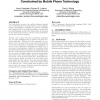Free Online Productivity Tools
i2Speak
i2Symbol
i2OCR
iTex2Img
iWeb2Print
iWeb2Shot
i2Type
iPdf2Split
iPdf2Merge
i2Bopomofo
i2Arabic
i2Style
i2Image
i2PDF
iLatex2Rtf
Sci2ools
ASSETS
2006
ACM
2006
ACM
MobileASL: : intelligibility of sign language video as constrained by mobile phone technology
For Deaf people, access to the mobile telephone network in the United States is currently limited to text messaging, forcing communication in English as opposed to American Sign Language (ASL), the preferred language. Because ASL is a visual language, mobile video phones have the potential to give Deaf people access to real-time mobile communication in their preferred language. However, even today’s best video compression techniques can not yield intelligible ASL at limited cell phone network bandwidths. Motivated by this constraint, we conducted one focus group and one user study with members of the Deaf Community to determine the intelligibility effects of video compression techniques that exploit the visual nature of sign language. Inspired by eyetracking results that show high resolution foveal vision is maintained around the face, we studied region-of-interest encodings (where the face is encoded at higher quality) as well as reduced frame rates (where fewer, better quality, fr...
| Added | 13 Jun 2010 |
| Updated | 13 Jun 2010 |
| Type | Conference |
| Year | 2006 |
| Where | ASSETS |
| Authors | Anna Cavender, Richard E. Ladner, Eve A. Riskin |
Comments (0)

